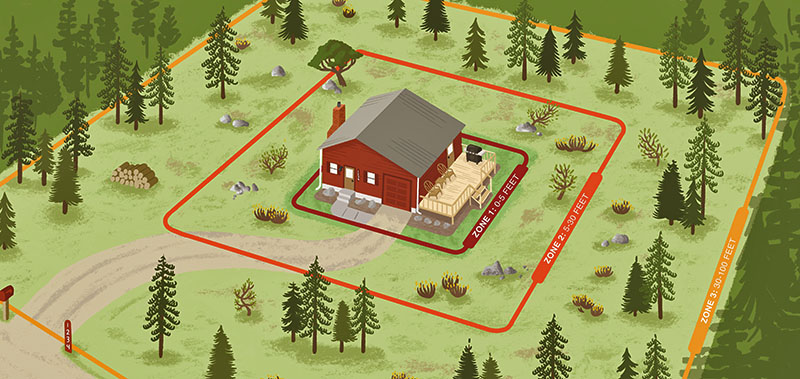Protect Your Home & Property from Wildfire

Photo courtesy Wildfire Partners
Take Action to Prepare Your Home & Property for Wildfire
Wildfires are a natural part of Colorado’s forests. If you live in the wildland-urban interface in Colorado, where homes and other structures intermingle with wildland vegetation, you are at risk of being affected by wildfire. Planning ahead and taking action can increase the likelihood your home survives when a wildfire occurs.
Firefighters always do their best to reduce fire damage, but ultimately, it is your responsibility to protect your property from wildfire. Taking practical steps to prepare your home does not guarantee it will survive a wildfire, but it does improve the odds. Any work completed may also allow firefighters who might be present to safely engage the fire and attempt to protect your property. If fire and site conditions are unsafe, firefighters will not be there.
As you address the home ignition zone on your property, always start with the home or structure and work outwards. Remember, taking action to prepare for wildfire is not a one-time effort — it requires ongoing maintenance to give your home the best chance of surviving a wildfire.
The Home Ignition Zone

The two primary determinants of a home’s ability to survive a wildfire are the structure’s ignitability and the quality of the surrounding defensible space. Together, these two factors create a concept called the home ignition zone, which includes the structure and the area around it.
To reduce wildfire hazards to your home and property, the most effective actions to take are to minimize the ability of the home to ignite during a wildfire and to reduce or eliminate nearby fuel.
Structural Ignitability
The likelihood the materials in and on your home will ignite during a wildfire is known as structural ignitability. The ideal time to address home ignition risk is when the structure is in the design phase. However, you can still take steps to reduce the ignitability of an existing home.
- Ensure the roof has a Class A fire rating
- Remove all leaves, needles and other debris from decks, roofs and gutters
- Screen attic, roof, eaves and foundation vents with 1/8-inch metal mesh
- Screen or wall-in stilt foundations and decks with 1/8-inch metal mesh
- Use tempered glass for windows; two or more panes are recommended
- Create 6 inches of vertical clearance between the ground and home siding
- Replace combustible fencing or gates, at least within 5 feet of the home
For more information on reducing a home’s structural ignitability, please refer to:
- Headwaters Economics – Building a Wildfire-Resistant Home: Codes and Costs
Defensible Space

Defensible space is the area around a home or other structure that has been modified to reduce fire hazards. In this area, natural and manmade fuels are treated, cleared or reduced to slow the spread of wildfire.
Establishing defensible space reduces the likelihood of a home igniting by direct contact with flame or by exposure to the radiant heat of the fire. It also helps limit local production of embers and reduces the chance a structure fire will spread to neighboring homes or surrounding vegetation.
Defensible Space Zones
Creating an effective defensible space involves establishing a series of management zones. Develop these zones around each building on your property, including detached garages, storage buildings, barns and other structures.
- Zone 1 (0-5 feet from the home) is the area nearest the home and other structures. It requires the most vigilant work to reduce wildfire hazards.
- Zone 2 (5-30 feet from the home) is the area transitioning away from the home where fuels should be reduced.
- Zone 3 (30-100 feet from the home) is the area farthest from the home. It extends 100 feet from the home on relatively flat ground.
Start Protecting Your Home with Our Help
For additional guidance on how to prepare your home for wildfire, including steps to manage the three defensible space zones:
- Home Ignition Zone Guide (2.7 MB PDF)
- La Zona De Ignición Del Hogar (1.1 MB PDF) – Spanish version of Home Ignition Zone Guide
- CSFS wildfire mitigation and education publications
- Home Ignition Zone checklists
Contact your local Colorado State Forest Service field office for guidance, or consult a natural resource professional, fire department or local organization appropriately trained in wildfire mitigation practices.

